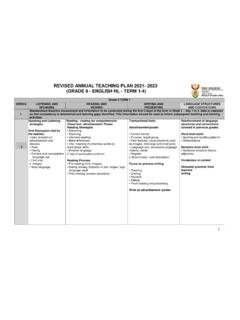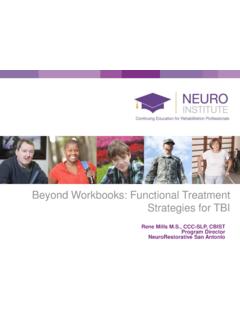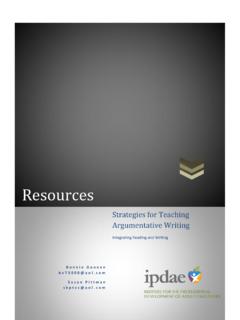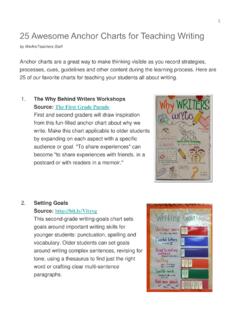Transcription of Graphic Organizers for Argumentative Writing
1 GED and GED Testing Service are registered trademarks of the American Council on Education. They may not be used or reproduced without the express written permission of ACE or GED Testing Service. The GED and GED Testing Service brands are administered by GED Testing Service LLC under license from the American Council on Education. Copyright 2015 GED Testing Service LLC. All rights reserved. Unpacking Prompts Do What Graphic Organizers for Argumentative Writing 2 Close Reading Questions After they have read the excerpt(s), can your students answer these questions? What is the author s argument? What position does the author take (for or against)? What is one point that supports the author s argument? What evidence does the author give to support this point? What is the point of view of the author? What is one point that refutes the author s point of view?
2 3 Both Sides Now When reading Argumentative non-fiction text, materials often present one side or viewpoint on a particular issue. Sometimes, the text may provide evidence to support both sides. Then, it is up to the reader determine which is best supported. Analyzing and evaluating the evidence for both sides is one way to identify a claim and the reasons for making a specific decision/claim. Both Sides Now Evidence that Supports Question or statement Which position is best supported? Evidence that Opposes Decision (Claim) Reasons (Analysis/Evaluation) 4 Prewriting Organizer: Toulmin Model for Argumentation A Claim: Is your point Is debatable Is demonstrated by reason and logic Thesis/Claim Statement: -_____ Warrants: Just like a search warrant from the police, the argument warrant gives the writer authority to proceed with his/her argument.
3 Is the assumption that makes your claim plausible questions the evidence shows a logical, persuasive connection between claim, reasons, data (evidence) gives authority to proceed with your argument can be stated, but usually is assumed Reason Conclusion REFUTE Reason Reason Reason 5 Constructed Response Organizer Prompt/Question: Restatement of question in own words (unpack it) Claim Evidence Detailed body of evidence or reasons that support answer include enough details to answer the question. Make sure all details support the claim and are not off-topic. Text 1 Text 2 Counterargument(s) Claim Rebuttal Restated question Concluding thoughts 6 Sample Thesis/Claim Frames A thesis is an answer to a specific question. A thesis statement makes a claim or proposition that reflects a specific point of view.
4 The thesis statement should recognize both sides of a question, yet focus on two to three specific points (discussion points) sometimes called points of analyses. A thesis statement is the roadmap for the written response. The placement of the thesis statement is generally located in the introduction and summarized in the conclusion of a Writing sample. The general argument made by _____ in his/her work _____ is that _____ because _____. Although _____ (believes, demonstrates, argues) that _____, _____ supports/provides the clearest evidence _____. A key factor in both _____ can be attributed to _____. When comparing the two positions in this article, _____ provides the clearest evidence that _____. Looking at the arguments regarding _____, it is clear that _____. In discussion of _____, one controversial issue has been _____. _____ believes that _____.
5 On the other hand, _____ asserts that _____. _____ is clearly the best supported argument on the issue of _____. 7 How Do You Know? Frames for Incorporating Evidence In the article, _____, _____ maintains that _____. _____ s point is that _____ ____ s claim rests upon the questionable assumption that _____ One reason that _____ maintains the position of _____ is that _____ According to the text/article/passage/report, _____ An example of _____, is _____ _____. This proves/supports that _____ The author states that _____ In addition, the author/article/research supports that _____ _____. This proves that _____. Examples/data supporting _____, include _____ 8 Explain the Evidence Teach students how to identify evidence through direct quotes, paraphrase the information, and explain how the evidence supports the claim/thesis. Claim Using a Direct Quote (What direct quote supports the claim?)
6 Paraphrasing (How can you rewrite the direct quote in your own words?) Explanation (How does the evidence support the claim?) 9 Sentence Structures: Helping Students Discuss, Read, and Write About Texts Students at all levels struggle to find language that expresses their ideas and helps them achieve their rhetorical purpose. Sentence structures offer a useful means of getting students up and running with academic language through either sentence starters or sentence frames. Both approaches are useful for Writing about and discussing different types of texts. Sentence Starters Sentence Frames Making Predictions I predict If x happens, Because x did y, I expect z. Making Connections X reminds me X is similar to y X is important to y Making Inferences X means .. since x Early on the author which suggests X X causes y as a result which Summarizing The main (central) idea The author argues In _____, (author s name) Evaluating The author s point is/is not valid The author does/does not do a good job The most important aspect/event/idea Analyzing the Text The author uses _____ to Summarizing Readers often assume While many suggest x, others say (Author s name)
7 Agrees/disagrees with x, pointing Responding X I agree/disagree with X s point assumes x, which I would argue While I agree that_____, you could also Agreeing Most will agree I agree with those who suggest X offers an effective explanation of why y happens, which is especially useful because most think Disagreeing I would challenge x s point about y, arguing X claims y, but recent discoveries show this While X suggests y, this cannot be true Taking the Third Path: Agreeing and Disagreeing While I agree , I reject the larger argument we now I share X s belief , but 10 The author assumes _____ which is/is not The use of _____ strengthens/weakens the author s argument Clarifying What the author is saying Given that x happened, the author is trying to X is not _____ but is, instead, _____ Synthesizing These elements/details, when considered together, Initial impressions suggested x, but after learning _____ it is now clear It is not a question of x but rather of y Most concede x though few would agree that y is Arguing Although x is increasing/decreasing, it is not y but z that is the While x is true, I would argue y because of z.
8 X was, in the past, the most important factor but y has changed, making it the real cause. Explaining Importance Based on x, people assumed y, which made sense at the time, but now we realize z, which This change questions our previous understanding of x, which means that now we must While this conclusion appears insignificant, it challenges our current understanding of x, which means Sentence starters and frames from: A Cognitive strategies Approach to Reading and Writing Instruction for English Learners in Secondary School, by Olson and Land in Research in the teaching of English (Feb 2007) and They Say/I Say: The Moves that Matter in Academic Writing , by Graff and Birkenstein (Norton 2006/2010). 11 Connecting Ideas Using Transitional Words and Phrases (Odell Education) Transitional words and phrases create link between your ideas when you are speaking and Writing .
9 They help your audience understand the logic of your thoughts. When using transitional words, make sure that it is the right match for what you want to express. Remember, transition words work best when they are connecting two or more strong ideas that are clearly stated. The following is a list of transitional words and phrases that you can use for different purposes. Add Related Information Give an Example or Illustrate an Idea Make Sure Your Thinking is Clearly Understood Compare Ideas or Show How Ideas Are Similar Contrast Ideas or Show How They Are Different furthermore moreover too also again in addition next further finally and, or, nor to illustrate to demonstrate specifically for instance as an illustration for example that is to say in other words to explain , (that is) to clarify to rephrase it to put it another way in the same way by the same token similarly in like manner likewise in similar fashion nevertheless but however otherwise on the contrary in contrast on the other hand Explain How One Thing Causes Another Explain the Effect or Result of Something Explain Your Purpose List Related Information Qualify Something because since on account of for that reason therefore consequently accordingly thus hence as a result in order that so that to that end, to this end for this purpose for this reason First, second, First, then, also.
10 Finally almost nearly probably never always frequently perhaps maybe although From Odell Education 12 Assessing the Claim Response Notes The Claim Is it debatable? Is the focus narrow enough for the Writing required? Does it establish the argument? Is it valid? The Evidence Does it support the claim? Does it include facts or statistics? Does it include examples? Is it based on an expert s or the writer s personal opinion? The Warrant Does it explain the pieces of evidence? Does it connect evidence to the claim? Is it reasonable? Does it make assumptions? Is it logical? The Counterclaim Does the writer include information that disagrees with the original claim? Is it reasonable? What is the evidence that supports the counterclaim? The Rebuttal Does it explain why the counterclaim does not work?





